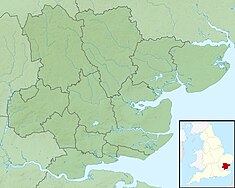Tilbury power stations
| Tilbury power stations | |
|---|---|

Tilbury B Power Station
Viewed from the west in May 2008 |
|
| Country | England |
| Location | Tilbury |
| Coordinates | 51°27′18″N 0°23′30″E / 51.454926°N 0.391677°ECoordinates: 51°27′18″N 0°23′30″E / 51.454926°N 0.391677°E |
| Status | Decommissioned |
| Commission date |
A station: 1956 B station: 1967 |
| Decommission date | 2013 |
| Owner(s) |
Central Electricity Generating Board (1956-1990) National Power (1990-2000) Innogy plc (2000-2002) npower (2002-2013) |
| Thermal power station | |
| Primary fuel | Coal |
| Secondary fuel | Oil |
| Tertiary fuel | Biomass |
| Power generation | |
| Nameplate capacity |
A station: 360 MW B station: 1,428 MW |
|
Website http://www.rwe.com/web/cms/en/97606/rwe-npower/about-us/our-businesses/power-generation/tilbury/ |
|
| grid reference TQ661756 | |
The Tilbury power stations were two fossil fuel power stations on the north bank of the River Thames at Tilbury in Essex. The 1,428 MW Tilbury B Power Station had operated between 1967 and 2013 and fired coal, as well as co-firing oil and biomass. The former oil-fired 360 MW Tilbury A Power Station operated from 1956 until 1981 when it was mothballed. The former system generated enough electricity to meet the electrical requirements of 1.4 million people, equivalent to 80% of the population of Essex.
Following construction which began in 1951, Tilbury 'A' station was commissioned in 1956 by the CEGB. It was mothballed in 1981 and eventually part demolished in 1999, mostly everything including the turbine hall was demolished. the waste water and a small part of the station still remains due to being a listed building
The CEGB began construction of a much larger new station, Tilbury 'B', in 1961. This was opened in 1968. On privatisation in 1990 it was assigned to National Power, but was later operated by RWE npower. The jetty was enlarged in 2004 to accommodate ships carrying up to 65,000 tons of coal.
In May 2011, RWE began converting the B station to burn biomass only. They hoped for the conversion to allow 750 MW of electricity to be generated from burning wood pellets imported from a pelleting plant in Georgia, USA, and other sources from Europe by the winter of 2011. This conversion would make the station the biggest biomass generating site in the world.
In July 2013 RWE npower announced they were halting the conversion due to difficulty in converting and financing the plant. It was mothballed after failing to receive a government grant and is now being decommisioned.
In early 2007, npower announced plans to replace the B station with a 1,600 MW 'cleaner' coal-fired power station. The station would have cost £1 billion to build and was hoped to be operational by 2014. The plans were supported by the Port of London Authority. RWE had also planned to build a clean coal power station at Blyth but they have since postponed both schemes.
...
Wikipedia

